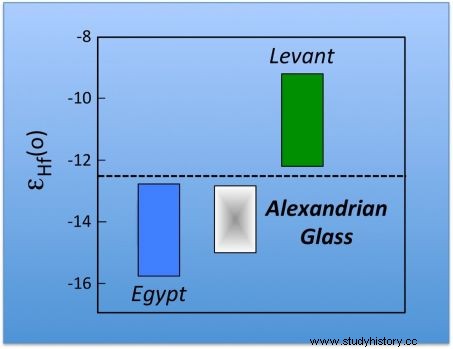It was a mystery two millennia old. Thanks to an analysis of the isotopic compositions of the material, researchers have finally been able to determine the origin of the "glass of Alexandria ”, reputed to be of the highest quality in the history of the Roman Empire.

Fragment of colorless glass called "from Alexandria" dating from the Roman Empire, having served during the study.
Led by researcher Gry H. Barfod from the University of Aarhus (Denmark), a research team attests to having discovered the secret of the origin of the “glass of Alexandria ”. The international collaboration of Danish, British and German researchers has been published in the journal Scientific Reports . This colorless glass is renowned as one of the most precious designed by the glassmakers of the Roman Empire.
If the name given to it testifies to an Egyptian origin, no archaeological discovery has confirmed this hypothesis so far. Indeed, huge glass production furnaces have been found in Palestine, where we know that a large majority of the glass of the Roman Empire was produced there. On the other hand, no such installation has ever been identified in Egypt by archaeologists. The “glass of Alexandria "Does he really come from Egypt, or from the Mediterranean countries of the Near East (especially on the Israeli coast)? To answer this nearly 2,000-year-old mystery, Professor Barfod's team turned to isotopic analysis.
A theory based on sand
At the time of the Roman Empire, glass was essentially made from sand. "The reason it's hard to tell the difference between glass made from Egyptian or Israeli sand is that these sands both come from the Nile" , explains to Sciences et Avenir Professor Barfod. "In these sands of the Nile, we find minerals called zircons, which contain hafnium." Hafnium is a chemical element of the class of transition metals, which has several dozen known isotopes. Isotopes of the same chemical element are “versions” of this element with a different number of neutrons. For example, carbon-14 is a radioactive isotope of carbon, well known to archaeologists (who use it to date fossils and sediments).
Hafnium isotopes as evidence of glass provenance
The theory put forward by Ms. Barfod and her team, based at the Jerash Northwest Quarter Project in Jordan was that, due to the variation in abundance on Earth between isotopes of the same element, some can be used as geographic tracers.
Led by researcher Gry H. Barfod from the University of Aarhus (Denmark), a research team attests to having discovered the secret of the origin of the “glass of Alexandria ”. The international collaboration of Danish, British and German researchers has been published in the journal Scientific Reports . This colorless glass is renowned as one of the most precious designed by the glassmakers of the Roman Empire.
If the name given to it testifies to an Egyptian origin, no archaeological discovery has confirmed this hypothesis so far. Indeed, huge glass production furnaces have been found in Palestine, where we know that a large majority of the glass of the Roman Empire was produced there. On the other hand, no such installation has ever been identified in Egypt by archaeologists. The “glass of Alexandria "Does he really come from Egypt, or from the Mediterranean countries of the Near East (especially on the Israeli coast)? To answer this nearly 2,000-year-old mystery, Professor Barfod's team turned to isotopic analysis.
A theory based on sand
At the time of the Roman Empire, glass was essentially made from sand. "The reason it's hard to tell the difference between glass made from Egyptian or Israeli sand is that these sands both come from the Nile" , explains to Sciences et Avenir Professor Barfod. "In these sands of the Nile, we find minerals called zircons, which contain hafnium." Hafnium is a chemical element of the class of transition metals, which has several dozen known isotopes. Isotopes of the same chemical element are “versions” of this element with a different number of neutrons. For example, carbon-14 is a radioactive isotope of carbon, well known to archaeologists (who use it to date fossils and sediments).
Hafnium isotopes as evidence of glass provenance
The theory put forward by Ms. Barfod and her team, based at the Jerash Northwest Quarter Project in Jordan was that, due to the variation in abundance on Earth between isotopes of the same element, some can be used as geographic tracers. "Our idea was that if mixtures of zircons of different sizes, densities, compositions, etc., were deposited along the coast [Egyptian and Israeli], one could observe a kind of systematic sorting “, she develops for Sciences et Avenir . "So if the "Alexandrian glass"was produced from Egyptian sands, we expected to observe differences [in isotopic compositions]compared to glasses made of Israeli sand". For the first time, the researchers were able to distinguish glasses made in Egypt from those from Near Eastern furnaces thanks to the different isotopic compositions of hafnium found. Indeed, as predicted by the Danish professor, the two sites have specific levels of hafnium 176 and 177 (see image below). And when we analyze the hafnium isotope composition of the fragments of “Alexandria glass ”, these coincide well with Egyptian productions!

Graph showing the hafnium isotopic composition of Roman and Byzantine glasses, known to have been made in the Near East (green) and Egypt (blue). "Alexandria glass" (white) has the same isotopic composition as glass produced in Egypt. Credits:Barfod, G.H., Freestone, I.C., Lesher, C.E. et al.
Read alsoThe extraordinary Roman dagger from Haltern am See
A new tool for archaeologists
“These exciting results clearly show the potential of hafnium isotopes in elucidating the origin of ancient materials. I predict they will become an important part of the scientific kit used in investigations of ancient economies ”, says in a press release the professor and co-author of the research Ian Freestone, of the Institute of Archaeology, University College London.
